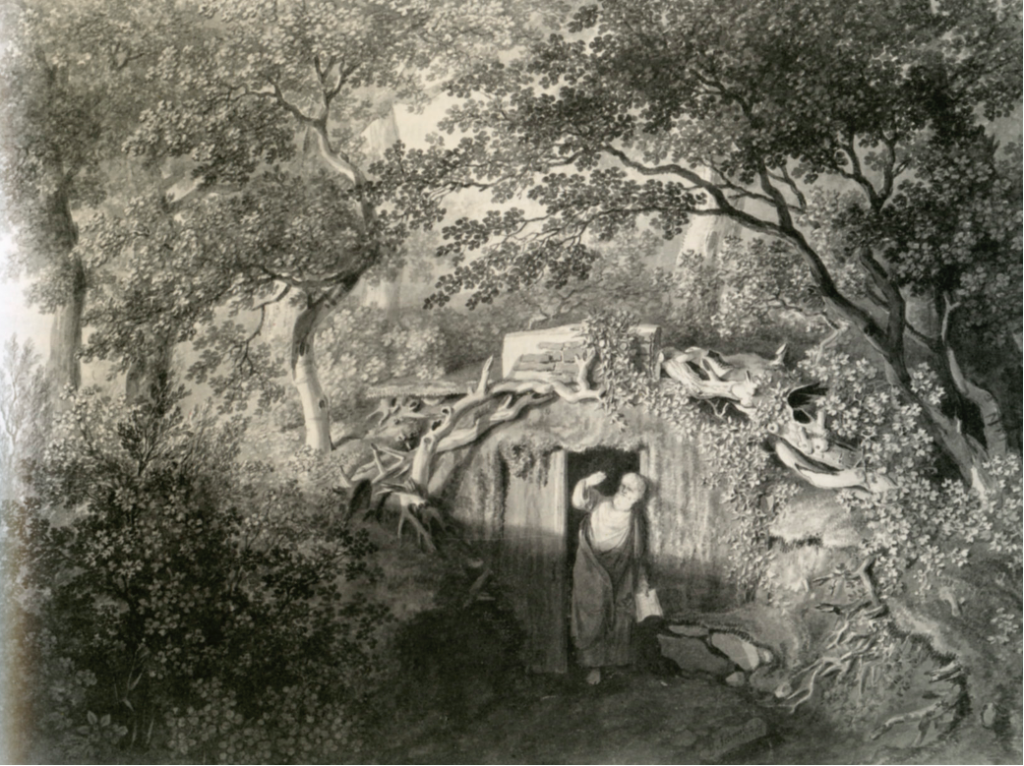The hermitage
(Poet's title: Die Einsiedelei)
Set by Schubert:
D 337
for TTBB quartet (stanzas 1, 2 and 5)[circa 1816]
D 393
[March 1816]
D 563
[May 1817]
Amat nemus et fugit urbes.
Horat.
Es rieselt klar und wehend
Ein Quell im Eichenwald,
Da wähl ich einsam gehend
Mir meinen Aufenthalt.
Mir dienet zur Kapelle
Ein Gröttchen, duftigfrisch,
Zu meiner Klausnerzelle
Verschlungenes Gebüsch.
Zwar düster ist und trüber
Die wahre Wüstenei;
Allein nur desto lieber
Der stillen Fantasei.
Da ruh ich oft im dichten,
Beblümten Heidekraut;
Hoch wehn die schwanken Fichten
Und stöhnen Seufzerlaut.
Wo von Wacholdersträuchen
Den Kieselsteig hinan
Verworrene Ranken schleichen,
Da brech ich mir die Bahn;
Durch des Gehaues Stumpen,
Wo wilde Erdbeern stehn,
Klimm’ ich auf Felsenklumpen,
Das Land umher zu sehn.
Nichts unterbricht das Schweigen
Der Wildnis weit und breit,
Als wenn auf dürren Zweigen
Ein Grünspecht hackt und schreit,
Ein Rab auf hoher Spitze
Bemooster Tannen krächzt,
Und in der Felsenritze
Ein Ringeltäubchen ächzt.
Wie sich das Herz erweitert
Im engen, dichten Wald!
Den öden Trübsinn heitert
Der traute Schatten bald.
Kein überleg’ner Späher
Erforscht hier meine Spur;
Hier bin ich frei und näher
Der Einfalt und Natur.
O blieb ich von den Ketten
Des Weltgewirres frei!
Könnt’ ich zu dir mich retten,
Du traute Siedelei!
Froh, dass ich dem Gebrause
Des Menschenschwarms entwich,
Baut ich hier eine Klause
Für Liebchen und für mich.
He loves the woods and flees the towns.
Horace
Clear and wafting, there is the rustling of
A spring in the oak wood;
Going there alone, that is the place I chose
For my residence.
Serving me as a chapel
There is a little grotto, scented and fresh;
For my hermit’s cell
There are entwined bushes.
It is really dark and gloomy,
That genuine wilderness;
Yet it is all the more attractive
For quiet application of the imagination.
I often rest there, amongst the thick
Flowering moorland herbs;
The tall, thin spruces sway
And emit a moaning, sighing sound.
There, growing out of the juniper bushes
Going up the pebble steps,
Twisting tendrils are creeping, and
That is where I have to clear my way forward;
Through chopped tree stumps,
Where there are wild strawberries,
I clamber onto lumps of rock
In order to look at the countryside around.
Nothing interrupts the silence
Of the broad wilderness going off into the distance,
Except when, on dried up branches
A green woodpecker pecks and cries out,
Or if there is a raven on the high point
Of a moss-covered fir tree and it caws,
Or in one of the cracks of the cliff-face
There is a dear little wood pigeon complaining.
How the heart broadens out
In the thick, confined forest!
Awful melancholy is cheered up
Quickly in its intimate shadows.
No supercilious scout
Will find a trace of me here;
Here I am free and nearer
To simplicity and to nature.
Oh, if only I could remain free from the chains
Of the world’s turbulence!
If only I could escape to you,
You cosy settlement!
Pleased at having escaped from the roaring
Of human swarms,
I would build a cell here
For the beloved and for me.
All translations into English that appear on this website, unless otherwise stated, are by Malcolm Wren. You are free to use them on condition that you acknowledge Malcolm Wren as the translator and schubertsong.uk as the source. Unless otherwise stated, the comments and essays that appear after the texts and translations are by Malcolm Wren and are © Copyright.
☙
Themes and images in this text:
Being solitary, alone and lonely Breaking and shattering Bushes and undergrowth Caves Chains and shackles Churches and chapels Doves and pigeons Flowers Fruit Grass Green Hearts Heathland and moors Herbs Melancholy Moss Mountains and cliffs Noise and silence Oak trees Hermits and hermitages Ravens Shade and shadows Sighs and sighing Springs, sources and fountains Spruce trees Steps and staircases Trees (general) Woods – large woods and forests (Wald)
The epigraph is from Horace, Book 2 Epistle 2, 77: Scriptorum chorus omnis amat nemus et fugit urbes (The whole chorus of writers loves the woods and escapes from towns).
This text was written while the author, Salis-Seewis, was serving as an officer in the company of Swiss Guards at the court of Versailles. He would thus have been familiar with the ‘rural retreat’, the Hameau de la Reine, that had recently been built for Queen Marie Antoinette in the palace gardens. Both the poem and the ‘resort’ reflect an aristocratic and artistic passion for hermitages at the time.
Perhaps the most famous example of this tradition was the ‘Hermitage’ in St. Petersburg, Russia, which Catherine the Great commissioned in 1764 to house part of the Imperial art collection. This was simply an extension to the winter palace (rather than a garden or rural retreat), but the idea of calling an art gallery a ‘hermitage’ was connected with the notion of escaping the ordinary pressures of the world to commune with higher things. A more typical example is perhaps that of the Eremitage, built and rebuilt (from 1715 onwards) by the Margraves of Bayreuth. This included grottos and water features alongside pavilions as part of an extensive garden complex away from the owner’s main residence and town. It represented part of the move away from the formal French garden style (established by 17th century Versailles) and towards the supposedly more ‘natural’ English garden style. The idea was that here, cut off from the pressures of normal society, it would be possible to be alone with nature and restore some of the simplicity and directness that had been lost in civilisation. Many English gardens included caves or grottos, and a fashion developed to employ individuals to play the part of hermits to give the impression that these spaces were ideal places for contemplation and reflection[1]. Some gardens put up tablets that included the final lines of Milton’s ‘Il penseroso’ (1632) to explain to visitors the purpose of the hermitages and grottos:
And may at last my weary age Find out the peaceful hermitage, The hairy gown and mossy cell, Where I may sit and rightly spell Of every star that heav'n doth shew, And every herb that sips the dew, Till old experience do attain To something like prophetic strain. These pleasures, Melancholy, give, And I with thee will choose to live.
Such ideas were given a further boost by the writings of Jean Jacques Rousseau (1712 – 1778), who stressed the baleful effects of conventional education and conformity to traditional social expectations. Rousseau used his own interest in botany to illustrate the value of relating directly (and individually) with the natural world rather than remaining shackled in society. Salis-Seewis seems to echo Rousseau in his detailed evocation of the specific plants (oak, spruce, juniper, wild strawberry etc) and birds (woodpecker, raven, wood pigeon) that will form his new environment. What is on offer here in nature is freedom and escape from the human realm, particularly when we are feeling low (in contrast to the passage from Milton, which suggests that the hermitage is the place to go in order to discover and indulge in melancholy).
The text builds up such a strong contrast between the loneliness of the human observer and the multiplicity of the life of the natural world in this secluded spot, it stresses the thrill of escape from the buzz and turmoil of society so insistently, that the final line of the poem comes as a powerful shock. Everything has led to the inevitable conclusion that the hermitage, the EINsiedelei (lit, the single settlement), is going to serve as the setting for the poet not just to play the part of a hermit (as in the tradition of ‘ornamental hermits’ in English gardens) but where he can actually become a real recluse. Now, we are told, the place isn’t just for him. He has his eye on it as a love nest; he wants a cell for two.
[1] Edith Sitwell, English Eccentrics London 1933 Chapter 2, ‘Ancients and Ornamental Hermits’; Tom Stoppard, Arcadia 1993


☙
Original Spelling
Die Einsiedelei
Amat nemus et fugit urbes.
Horat.
Es rieselt, klar und wehend,
Ein Quell im Eichenwald;
Da wähl' ich, einsam gehend,
Mir meinen Aufenthalt.
Mir dienet zur Capelle
Ein Gröttchen, duftigfrisch;
Zu meiner Klausnerzelle
Verschlungenes Gebüsch.
Zwar düster ist und trüber
Die wahre Wüsteney;
Allein nur desto lieber
Der stillen Fantasey.
Da ruh' ich oft im dichten,
Beblümten Heidekraut;
Hoch wehn die schwanken Fichten,
Und stöhnen Seufzerlaut.
Wo von Wacholdersträuchen
Den Kieselsteig hinan
Verworrene Ranken schleichen,
Da brech' ich mir die Bahn;
Durch des Gehaues Stumpen,
Wo wilde Erdbeern stehn,
Klimm' ich auf Felsenklumpen,
Das Land umher zu sehn.
Nichts unterbricht das Schweigen
Der Wildniß weit und breit,
Als wenn auf dürren Zweigen
Ein Grünspecht hackt und schreyt,
Ein Rab' auf hoher Spitze
Bemooster Tannen krächzt,
Und in der Felsenritze
Ein Ringeltäubchen ächzt.
Wie sich das Herz erweitert
Im engen, dichten Wald!
Den öden Trübsinn heitert
Der traute Schatten bald.
Kein überleg'ner Späher
Erforscht hier meine Spur;
Hier bin ich frey und näher
Der Einfalt und Natur.
O blieb' ich von den Ketten
Des Weltgewirres frey!
Könnt' ich zu dir mich retten,
Du traute Siedeley!
Froh, daß ich dem Gebrause
Des Menschenschwarms entwich,
Baut' ich hier eine Klause
Für Liebchen und für mich.
Confirmed by Peter Rastl with Schubert’s source, Gedichte von J. G. von Salis. Neueste Auflage. Wien 1815. Bey B. Ph. Bauer, pages 57-59; and with Gedichte von J. G. von Salis. Gesammelt durch seinen Freund Friedrich Matthisson. Zürich, bey Orell, Gessner, Füssli und Compagnie. 1793, pages 61-63.
First published in Musen-Almanach für 1789. Herausgegeben von J. H. Voß. Hamburg, bey Carl Ernst Bohn, pages 179-181.
To see an early edition of the text, go to page 57 [71 von 192] here: http://digital.onb.ac.at/OnbViewer/viewer.faces?doc=ABO_%2BZ160622604


